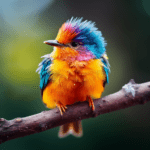
- No Teeth, No Problem: Birds don’t have teeth! Instead, they use their beaks to capture, chew, and swallow their food. Some birds even swallow small stones to help grind up their meals in their stomachs.
- One-Hearted Flyers: Birds have relatively large hearts compared to their body size. In fact, a bird’s heart makes up about 1-2% of its total body weight, helping to provide the energy needed for their high metabolism and active lifestyles.
- Monogamy and Extra Pairs: While many birds are known for their monogamous behavior, some species engage in “extra-pair copulation,” where they mate with individuals other than their partners. This helps increase genetic diversity within a population.
- Swift Sleepers: Some birds, like certain species of swifts, are known for their ability to sleep while flying. They can shut down half of their brain at a time, alternating between brain hemispheres to rest and maintain control of flight.
- Tools of the Beak: New Caledonian crows are remarkable tool users. They’ve been observed using sticks, leaves, and even their own feathers to create tools for foraging. These crows are known for their problem-solving abilities.
- Migratory Marvels: The Arctic Tern holds the record for the longest migratory journey of any bird. It travels about 44,000 miles (71,000 km) annually between its breeding grounds in the Arctic and its wintering grounds in Antarctica.
- Dancing Manakins: The male Club-winged Manakin of South America uses its specially adapted wing feathers to create a musical display. By rubbing its wings together at an incredible speed, it produces a unique high-pitched tone to attract females.
- Moonlit Singers: Some birds, like the Northern Mockingbird, are known to sing at night when the moon is bright. This behavior is thought to be a way to attract mates during the nighttime hours.
- Super-Synchronized Flocks: Starlings are famous for their mesmerizing aerial displays known as murmurations. Thousands of birds fly together in intricate patterns, avoiding collisions through rapid communication and response.
- Echolocation in Blind Birds: The Oilbird, a nocturnal bird from South America, uses echolocation to navigate in complete darkness. Despite having functional eyes, its primary sense for navigation is sound, allowing it to find its way in pitch-black caves where it roosts.
Birds are truly fascinating creatures with a wide range of unique behaviors and adaptations that have evolved over millions of years.

